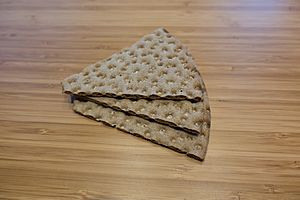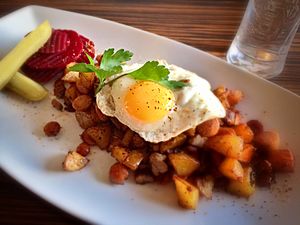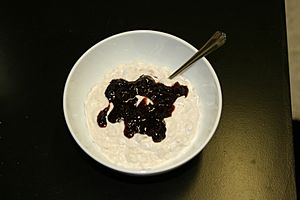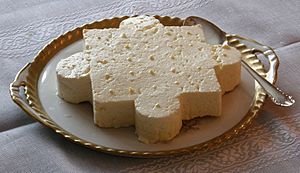Swedish cuisine facts for kids
Swedish cuisine (called Svenska köket in Swedish) is the traditional food from Sweden. Because Sweden is a long country stretching from north to south, the food traditions are a bit different in the north compared to the south.
Long ago, people in the far north ate meats like reindeer and other wild game. Some of these foods came from the Sámi people's culture. In the south, fresh vegetables were more common. Many traditional Swedish dishes use simple, clear flavors. A good example is the famous meatballs with a rich cream sauce and tangy lingonberry jam. Lingonberry jam tastes a bit like cranberry sauce.
Swedes have always been open to new food ideas from other countries. In the 1700s and 1800s, French cooking was popular. Today, you can find foods like sushi and caffé latte in Sweden.
Contents
What Makes Swedish Food Special?
Swedish food often uses dairy products like milk and cheese, crunchy or soft breads (often sweet), and lots of berries and fruits. Common meats include beef, chicken, lamb, and pork. Eggs and seafood are also very popular. Potatoes are a common side dish, usually boiled.
Sweden has many kinds of bread. They are made from rye, wheat, or oat, and can be white, dark, or whole grain. There are also flatbreads and crispbreads. Many breads are a little sweet, and some have spices.
You'll often find lingonberry jam served with meat dishes, especially meatballs. Fruit soups, like rose hip soup and blueberry soup (called blåbärssoppa), are also common. They can be served hot or cold. Butter and margarine are the main fats used, but olive oil is becoming more popular.
Swedes love pastries! They have many types of sweet buns, cookies, and cakes. These are often very sugary and enjoyed with coffee during a special break called fika.
A Look Back at Swedish Food History
Fish has always been super important in Sweden's history, affecting where people lived and traded. To keep fish fresh, people used to salt and cure it. Salt became a big trading item around the year 1000 AD, when the Scandinavian Middle Ages began.
In the past, people used cabbage (preserved as sauerkraut) and different kinds of preserved berries and apples. These helped them get vitamin C during the long winters. Today, sauerkraut is not very common in Sweden. But lingonberry jam is still a favorite! It adds a fresh taste to hearty meals like steaks and stews.
Sweden's long, cold winters meant there weren't many fresh vegetables available. So, people relied on plants that could last through winter. Turnips, like the kålrot (which is called "swede" in British English), were very important. Later, in the 1700s, potatoes became a main food source.
Traditional Swedish food often used few spices. This is still true today; Swedish dishes are usually lightly spiced.
Over time, new dishes came to Sweden from other countries. For example, people from the Hanseatic League (a group of trading cities) brought German foods when they settled in Swedish cities. Swedish traders and noble families also picked up food ideas from abroad. One example is cabbage rolls (kåldolmar). These were brought to Sweden by King Karl XII in the 1700s after he spent time in the Ottoman Empire.
What is Husmanskost?
Husmanskost is the name for traditional Swedish everyday food. It uses local ingredients. The word husman means 'house owner', and it used to describe simple country food.
Real Swedish husmanskost mainly uses local foods like pork, fish, grains, milk, potatoes, root vegetables, cabbage, onions, apples, and berries. Beef and lamb were used less often. Besides berries, apples are the most common traditional fruit. They are eaten fresh or used in apple pie, apple sauce, or apple cake.
Cooking methods for husmanskost often take a long time. Spices are used sparingly. Some examples of Swedish husmanskost are:
- Pea soup (ärtsoppa)
- Mashed carrots, potatoes, and rutabaga with pork (rotmos med fläsk)
- Many kinds of salmon (like gravlax, boiled salmon, fried salmon, pickled salmon)
- Different types of herring (pickled, fried, baked)
- Fishballs (fiskbullar)
- Meatballs (köttbullar)
- Potato dumplings with meat (palt)
- Potato pancakes (raggmunk)
- Porridge (gröt)
- A fried mix of potatoes, meats, sausages, bacon, and onion (pytt i panna)
- Meat stew with onion (kalops)
- Potato dumplings filled with onions and pork (kroppkakor)
Many of these dishes are considered "comfort food" because they bring back good memories. Similar traditional foods are also found in other Scandinavian countries.
In recent years, husmanskost has become popular again. Famous Swedish chefs have created modern versions of these classic dishes. They use less fat (which was needed for hard work in the old days) and sometimes add new ingredients. They also change cooking methods to make food faster or healthier. Many Swedish restaurants now mix traditional husmanskost with a modern, fancy touch.
Popular Swedish Dishes
Many traditional Swedish dishes, some hundreds of years old, are still eaten every day. Even though modern Swedish cooking includes many international dishes, these classics remain important.
Internationally, the most famous Swedish food tradition is the smörgåsbord. This is a buffet with many different dishes. At Christmas, there's a special julbord (Christmas buffet) with famous Swedish foods like gravlax (cured salmon) and meatballs.
In Sweden, Thursday has traditionally been "soup day." This is because maids used to have half the day off, and soup was easy to prepare ahead of time. One of the most traditional Swedish soups, ärtsoppa, is still served in many restaurants and homes every Thursday. This tradition goes back to the Middle Ages. Ärtsoppa is a yellow pea soup, often served with pancakes for dessert. It's a simple, thick soup made from boiled yellow peas, a little onion, salt, and small pieces of pork. It's often eaten with mustard. Even the Swedish Armed Forces serve pea soup and pancakes to their soldiers every Thursday!
Potatoes are eaten all year round as the main source of energy. They are a key part of many traditional dishes. Pasta or rice only became common at dinner tables in the last 50 years. There are different kinds of potatoes. The most loved are "new potatoes," which are ready in early summer. They are a highlight of the traditional midsummer celebration. At midsummer, new potatoes are served with pickled herring, chives, sour cream, and the first strawberries of the year for dessert.
The most prized mushroom in Sweden is the chanterelle. It's a special treat! Chanterelles are usually served with steaks or fried with onions and sauce on an open sandwich. The porcini mushroom, or karljohansvamp, is also very popular. It's named after King Charles XIV John who helped make it a common food.
In August, Swedes have a traditional party called kräftskiva, or "crayfish party." People eat lots of crayfish that have been boiled and marinated in a broth with salt, a little sugar, and lots of dill.
Some other Swedish dishes include:
- Blodpudding: A sweet and spiced blood pudding, eaten with lingonberry jam and sometimes bacon.
- Falukorv: A large, thick sausage from Falun. It was originally made from meat from oxen that worked in the copper mine.
- Flygande Jacob: A casserole with chicken, cream, chili sauce, bananas, peanuts, and bacon. It was invented in the 1970s.
- Janssons frestelse: A potato casserole with grated potatoes, onion, anchovy (a small fish), and cream.
- Julskinka: Cured ham, boiled and coated with mustard and breadcrumbs. It's the Swedish equivalent of a Christmas turkey.
- Köttbullar: Meatballs made from meat and herbs, often served with mashed potatoes and pickles.
- Korv Stroganoff: Sliced sausage (usually falukorv) in a creamy tomato sauce. It's a simpler version of Beef Stroganoff.
- Lutfisk: Dried fish treated with lye.
- Pyttipanna: A mix of chopped and fried meat, onions, and potatoes, often made from leftovers.
- Raggmunk: Potato pancakes, usually eaten with lingonberry jam and fried pork belly.
- Räksmörgås: An open sandwich with prawns, egg, and mayonnaise, often with lettuce, tomato, cucumber, lemon, and dill.
- Smörgåstårta: A "sandwich cake" with many layers and different fillings like shrimp, ham, and mayonnaise.
- Stekt strömming: Fried herring fillets, often served with mashed potatoes and lingonberry jam.
- Surströmming: Fermented Baltic herring. It has a very strong smell and unique taste, which some Swedes love and others dislike! It's usually eaten with thin, hard bread.
- Wallenbergare: A patty made from ground veal, cream, and egg yolks, coated in breadcrumbs.
Meals in Sweden
Swedes usually have breakfast (frukost) in the early morning, a light lunch (lunch) before noon, and a big dinner (middag) around 6 or 7 in the evening. It's also common to have a snack (mellanmål), like a sandwich or fruit, between meals. Most Swedes also enjoy a coffee break in the afternoon, often with a pastry (this is fika).
In all primary schools and most secondary schools, a hot meal is served for lunch. This is part of Sweden's system to support its citizens. By law, these school meals must be healthy and nutritious.
Breakfast Foods

Breakfast usually includes open sandwiches (smörgås). These are often made with crisp bread (knäckebröd). The sandwich usually has butter and toppings like hard cheese, cold cuts, caviar, messmör (a sweet spread from Norway), ham (skinka), and tomatoes or cucumber.
Filmjölk (fermented milk, like buttermilk) or yogurt is also a traditional breakfast food. It's usually served in a bowl with cereals like corn flakes or muesli. Porridge (gröt) made from oatmeal or cream of wheat is also eaten, often with milk and jam or cinnamon sugar. Common breakfast drinks are milk, juice, tea, or coffee. Swedes drink a lot of milk and coffee!
Some Swedes put sweet toppings on their bread, like jam or chocolate. However, many older Swedes prefer not to. Orange marmalade on white bread is common with morning coffee or tea.
Many traditional Swedish breads, like sirapslimpa, are slightly sweet because they are baked with a little syrup. Like in other European countries, there are also many non-sweetened breads, often made with sourdough (surdeg). Swedish breads can be wholegrain, fine grain, or anything in between. They come in white, brown, and very dark varieties. Barkis or bergis is a Swedish version of challah bread.
Seafood Delights
Fish and other seafood are a very important part of Swedish cooking. Salmon farmed in Norway has become more and more popular. Pickled, sweetened herring (inlagd sill) is a traditional Swedish appetizer. Shrimp and lobster are special foods from the Skagerrak coast. Surströmming is a fermented Baltic herring famous for its strong smell.
Sweet Desserts
Common Swedish desserts include:
- Gotländsk saffranspannkaka: A rice pudding dessert with saffron from Gotland. It's usually served with jam or whipped cream.
- Kalvdans: A classic dessert made from the first milk a cow produces after giving birth.
- Klappgröt: Semolina pudding mixed with juice from red currant, lingonberries, raspberries, or blackberries. It's stirred until fluffy and eaten cold.
- Ostkaka: Swedish cheesecake, which is very different from American cheesecake.
- Pannkaka: Pancakes are almost never eaten for breakfast like in America. They are usually served as a dessert with sweet jam or whipped cream, or as a meal on their own with fewer sweet toppings.
- Smördegspaj (Butter dough pie) and Smulpaj (Crumb pie): Various kinds of pies and cookies are typical desserts, often served with coffee. Common pies are apple pie, blueberry pie, and rhubarb pie.
- Spettekaka: A sweet, dry, hollow Swedish cake shaped like a cylinder. It's similar to Meringue and found only in the southern province of Scania.
- Våfflor: Waffles, often served with jam and whipped cream or ice cream. Waffles even have their own day on March 25th!
- Äggost: A dish from Bohuslän. In the south, it's a dessert with whipped cream, sugar, and blackberry jam. In the north, it's often a main dish or breakfast with pickled herring.
Swedish Pastries and Treats
Kaffebröd (Coffee Bread)
Bakelser and other types of kaffebröd (or fikabröd) are different kinds of pastries, cakes, cookies, and buns. They are usually eaten with coffee during a fika. Popular kaffebröd you can find in a Swedish konditori (coffee shop/bakery) include:
- Kanelbulle: A Cinnamon roll, sometimes made with cardamom dough.
- Wienerbröd: A Danish pastry that comes in many shapes and varieties.
- Chokladboll: A round, chocolate-flavored ball made with oatmeal, cocoa, and sugar. It's covered in coconut flakes or pearl sugar.
- Kringla: A small, sweet, pretzel-shaped cookie with pearl sugar on top.
- Punschrulle: A small, cylindrical pastry covered in green marzipan with chocolate-dipped ends. Inside, it has a mix of crushed cookies, butter, and cocoa, flavored with punsch liqueur. This pastry is often called dammsugare ('vacuum cleaner') because of its shape.
- Biskvi: A small, round pastry with an almond and sugar base, filled with butter cream, and covered with a thin layer of chocolate.
- Prinsesstårta: A large cake with sponge cake layers, whipped cream, and custard under a green marzipan coating. It's topped with powdered sugar and often a pink marzipan rose.
- Budapestbakelse: Made from sugar, egg white, hazelnuts, whipped cream, and fruit pieces like apricot or mandarine. It's decorated with chocolate and powdered sugar.
- Napoleonbakelse: Made of pastry dough, whipped cream, custard, and jam, topped with icing and currant jelly.
- Kladdkaka: A chocolatey and sticky flat cake.
- Toscakaka: A light sponge cake topped with caramelized almonds.
- Arraksboll: A ball flavored with arrak, similar to a chokladboll but with a very different taste.
Seasonal and Other Treats
During the winter holidays, traditional candies and pastries include:
- Knäck: Christmas toffee. It's usually hard and meant to be sucked, not chewed.
- Ischoklad: Coconut oil mixed with chocolate.
- Marmelad: Rectangular fruit and pectin-based candies in various colors.
- Lussekatt: A Saffron bun, eaten on the Saint Lucia celebration (December 13th).
- Pepparkaka: Similar to ginger snaps. These have been eaten since the 1300s and are strongly linked to Christmas.
- Semla: After the new year, the fastlagsbulle (Lenten bun), or semla, is baked. It's a wheat bun with a cream and almond paste filling, traditionally eaten on Shrove Tuesday.
Other typical Swedish candies include:
- Saltlakrits: Liquorice candy flavored with ammonium chloride.
- Polkagris: Traditional peppermint stick candy from Gränna, also made in other flavors.
- Ahlgrens bilar: A marshmallow candy shaped like a car. It's marketed as "Sweden's most purchased car."
- Sockerbitar: Similar to square, chewy marshmallows.
- Geléhallon: An early type of gelatine-based candy.
- Daim: A crunchy chocolate bar.
Popular Swedish Drinks
Sweden is one of the top countries for coffee drinking in the world. Milk consumption is also very high, second only to Finland. Milk is sold in cartons, and it's no surprise that Tetra Pak, the world's largest maker of milk cartons, was founded in Sweden. Milk is considered the standard drink with meals during weekdays for both children and adults in many families.
Low-fat products, wholemeal bread, and other healthy options are common. Grocery stores usually sell milk with four or five different fat levels, from 3% to 0.1%.
Christmas Drinks
- Mumma: A traditional Christmas drink. It's usually a mix of dark beer, light beer, port wine, and something sweet like sockerdricka or julmust. It's often spiced with cardamom.
- Glögg: Mulled wine.
Sweet Drinks

- Blåbärssoppa: Bilberry Soup. A sweet soup or drink made from bilberries, served hot or cold.
- Enbärsdricka: A Juniper berry soft drink.
- Sockerdricka: A sweet-sour carbonated soft drink.
- Fruktsoda: A traditional lemon-lime carbonated soft drink.
- Champis and Pommac: Carbonated soft drinks that are alternatives to sparkling wine.
- Trocadero: A soft drink with the taste of apple and oranges, originally from northern Sweden.
- Julmust: A sweet, seasonal carbonated soft drink, very popular at Christmas (jul means Christmas).
- Lingondricka: Lingonberry drink.
- Nyponsoppa: Rose Hip Soup. A sweet soup or drink made from rose hips, served hot or cold.
Traditional Swedish Drinks
Punsch is a traditional liqueur in Sweden that was very popular in the 1800s. University students especially loved it. Many old songs from that time are about drinking punsch or are sung during student parties, a tradition that continues today.
Beer in Sweden
Beer is also widely consumed in Sweden. The typical Swedish beer is a light and malty lager. Brands like Pripps Blå and Norrlands Guld are common. In recent decades, many small breweries (called microbreweries) have started all over Sweden. They offer many different styles and brands of beer. Some of these microbreweries are inspired by the craft beer movement in the US, making American styles like American Pale Ale and American IPA.
Food and Society in Sweden
In the past, organizations like 'The Bread Institute' and the Swedish National Board of Health and Welfare encouraged Swedes to eat healthy. For example, they recommended eating six to eight slices of bread daily and drinking two to three glasses of milk per day. A survey once found that 52% of Swedes drank milk at least once a day.
Swedish grocery stores often sell milk in four or five different fat levels. They also offer many low-fat products and wholemeal breads.
See also
 In Spanish: Gastronomía de Suecia para niños
In Spanish: Gastronomía de Suecia para niños









